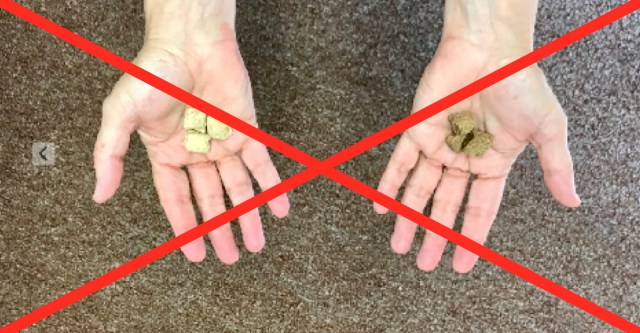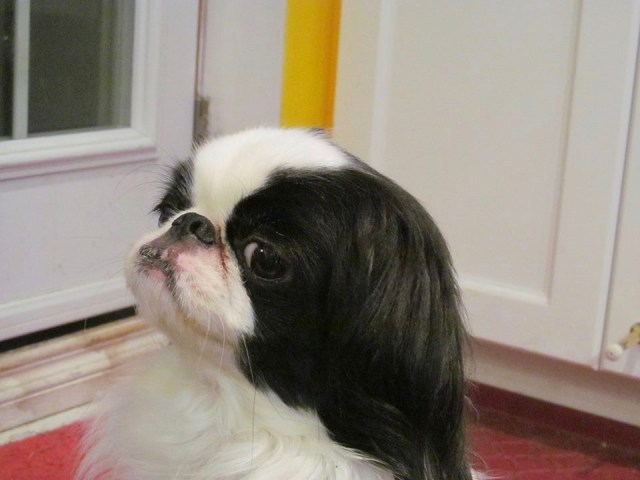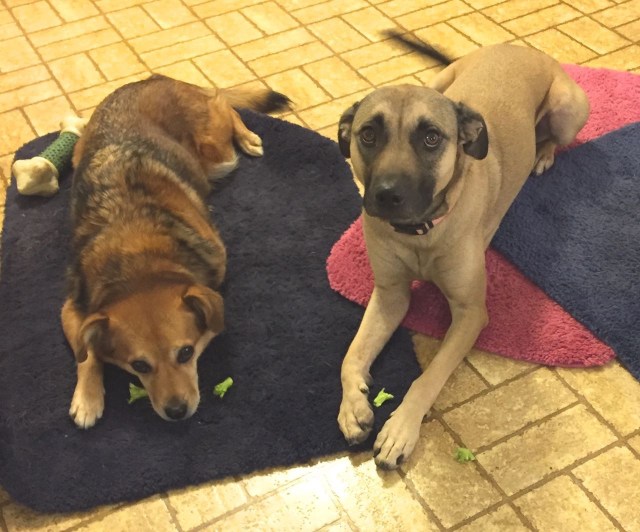Barks Blog
So Tell Me What You Want, What You Really Really Want: Nine Ways Preference Testing Can Go Wrong
What’s your favorite color?
Do you prefer pie or ice cream?
Which shirt do you like better: the striped one or the solid green one?
Most of us have been asked our preferences since we were children. Sometimes we are being asked to make a choice: if we choose the striped shirt we won’t be wearing the green one also. If we are asked to choose enough times, our preferences often become clear.
With the best intentions, many of us are attempting to determine our dogs’ preferences by trying to offer them choices. There are quite a few articles out there in the dog training world that include instructions on how to do that.
Most say that we are supposed to hold a different item in each hand (usually toys or two different foods), and see which one the dog “chooses.” Or we may have items on two plates on the floor. Whichever item the dog doesn’t move toward or otherwise express an interest in, we take away. In the literature, this is called a “paired stimulus preference assessment.”
We are told we that if we do this procedure several times, we can learn his preference.
Wellll….not necessarily.
There are quite a few assumptions in that scenario. We assume that the dog understands choice: that he gets to pick one thing and the other will go away. (Why are we such control freaks that we so often couple choice-making with taking something away? It’s not always necessary.) We assume that the item the dog goes to first or indicates in some way is preferred.
The problem is that we can’t assume these things. There is a whole sub-branch of learning theory called “preference assessment.” There are different methods and protocols because it is usually not as simple as offering two things in different hands, especially to a non-verbal creature such as a dog.
Here are nine reasons why the “which hand do you want?” process may not work to determine preference in a dog. After the list, I’ll cover some other kinds of preference tests with examples from a good site. Finally, I’ll give some hints for performing the paired stimulus test more effectively if you want to stick to that one.
Potential Problems With the Paired Stimulus Preference Test
- Sidedness. Many dogs have a preferred side. (This is called a directional bias.) When scientists in labs work on choice problems, they usually run some pre-tests about biases. They’ll remove from the trials the animals that consistently go to the item on a particular side.
- Handler body language. Our dogs look at us for physical cues. If we stand there with treats, many will think that we are asking them for behavior, rather than asking what they want. It looks like a training session! So they may try to figure out what behavior will be reinforced. They’ll follow our body language: our hands, our leaning, our gaze. Then they’ll interact in some way with the object that we appear to be indicating.
- Handler bias. If the dog’s actions are not clear to us, our human brains are usually all too happy to step into the void with an interpretation. This will be subject to the normal sets of biases that humans have.
- Previous reinforcement history of targeting. Our dogs may have a greater reinforcement history for targeting one of our hands over the other. It might kick right in when we put our hands out. If I hold out both of my hands, either empty or while holding small objects, my dogs will generally target my right hand, no matter what’s in it. That’s because I have taught them a hand target and I do it far more with my right hand than with my left.
- Previous reinforcement history of leave-it. This is the corollary of the targeting issue. With some dogs it will be hard to get them to take either item—from hands or even from plates on the floor. This can happen if we have taught a very strong “leave-it.” By the time we have convinced them that it’s OK to take the object, we may have moved around the room or gestured. This can affect the dog’s “choice.”
- Visual presentation. There are several ways that the visual presentation can affect the outcome. One is that dogs see colors differently from how we do. Another is that many dogs will regularly take the larger item. And of course, some dogs’ vision may be impaired on one side or the other.
- Noticing the wrong characteristic. When it comes to toys, all three of my dogs will generally be more interested in a new toy than a familiar one. That in itself is a good thing to know: novelty is a big draw. But if I want to know their preferences beyond that, I have to account for novelty. Either all of the items should be novel or none of them. This is one of many factors we have to control for when we give paired choices. There are studies on preference that assess previous factors (establishing operations) that can affect the choice.
- Different sensory abilities of dogs and humans. This is related to #7. Our dogs may actually be affected by some stimulus we are unaware of. Maybe the hand that has the better treat has some leftover odor from a cleaning product. Eww. Better go for the other one…
- Reinforcement history that builds through the exercise. This is a common point of confusion. If we offer some items to our dog intending to give him a choice, he may perform a behavior involving us or the item. Then the behavior gets reinforced by his getting the item. If we do this repeatedly, we build up a reinforcement history for whatever behavior the dog is doing. For instance, it could be targeting the right hand or running to the closest plate. Building that reinforcement history interferes with the goal of getting an untainted preference from the dog. (This problem is inherent in some choice exercises as well. For example, if a dog is reinforced heavily for a certain stationing behavior for husbandry and is allowed to take a break, we can’t determine that when the dog comes back he is “choosing” for the husbandry to continue. He is performing a heavily reinforced behavior. We can’t know how the dog perceives the exercise.)
Some of these things can work out over time. But even in the best-case scenario, the paired stimulus preference assessment will need to be performed many times.
ABA Preference Testing
Luckily, there are procedures that address problems like those I’ve listed. The applied behavior analysts who work with children use preference tests to help determine what foods and items will be effective reinforcers for individuals. Some of these tests can carry over nicely into dog training.
An informative article from Vanderbilt University lists five different methods for preference assessment.
- Multiple Stimulus without Replacement (MSWO) Preference Assessments
- Multiple Stimulus with Replacement (MSW) Preference Assessments
- Paired Stimulus Preference Assessments
- Single Stimulus Preference Assessments
- Free Operant Observations
Each method has a secondary linked article with a video example of the method.
One factor that is considered when choosing a method is whether the child can understand the verbal instructions. (You will hear the analyst saying things like, “Just pick one. You can play with a different one later.) Another is whether the child is likely to get violent if a toy is taken away as part of the test. The first methods above, including the paired stimulus preference assessment, do seem to rely on the child’s understanding of verbal instructions.
However, the last two in the list are observational exercises. In the single stimulus preference assessment, the child is given access to one item while the analyst observes. The analyst records the amount of time the child plays with the item, and will later do so with other items and compare the data. In free operant observations, many toys and items are available at once. The observer records the amount of time the child plays with each toy or engages in other activities. The authors note that an advantage of free operant observation is that the analyst may observe activities that adults might not have thought of as possible reinforcers.
Single stimulus and free operant observations are not as flashy as a paired stimulus tests, but they also avoid most of the problems I list above. And when we live with our animals we can perform these observations frequently. Most of us can already name a few of our dogs’ favorite foods, or what he especially likes in a toy. Then there are those surprise moments. I’ll never forget when I unwrapped a rubber tug toy Marge Rogers sent and offered it to each dog in turn. Summer wasn’t interested. Clara tugged politely, then looked for a treat. And Zani went berserk over it. It’s still probably her favorite thing to tug.
If You Want To Do the Paired Stimulus Preference Test
Look at each of my nine points above and think how you would mitigate that. Because of possible directional bias, be sure to offer the same two items in different positions at for different trials. Do you discover then that your dog always takes the one on the right side? For body language: What happens if you stare at or lean toward an item? Can you try for as neutral body language as possible? Here are a few more tips for doing the paired stimulus test if you are serious about getting good results. I gleaned most of the tips from the above articles.
- Plan to do it a lot. It’s unlikely that you can do it once and determine your dog’s preference, or even that the dog will understand you are asking him to choose.
- Start with pairs of items for which you know the outcome—a clear favorite and a dud. For instance, I can predict that my dogs would choose a bite of pork chop over a sprig of broccoli (see above photo). If the dog takes the broccoli, we can deduce that the dog is not expressing a preference. (But conversely, we can’t assume that the dog is expressing a preference if he takes the bite of pork chop. We have to do more tests.) Anyway, do plenty of trials where you are pretty sure of the outcome. You can study your dog’s responses, and your dog may overcome some of the reinforcement history problems I mention above.
- Do a “round robin” format. If you have six items, pair each of the six with each of the others for an iteration. Then at another time, do it again but reverse the sides on which you offer the items.
- Track your results! This is too much data to keep in your head.
- Remember to include which sides you offer things on in your reporting.
- Do lots of repetitions over time. Tastes change.
Good for you for wanting to know what your dog loves best!
Copyright 2017 Eileen Anderson
Photo of Ni Kokoro Omeshi Yakata Chanoyu, “Meesh,” the Japanese Chin, Copyright 2017 Blanche Axton




